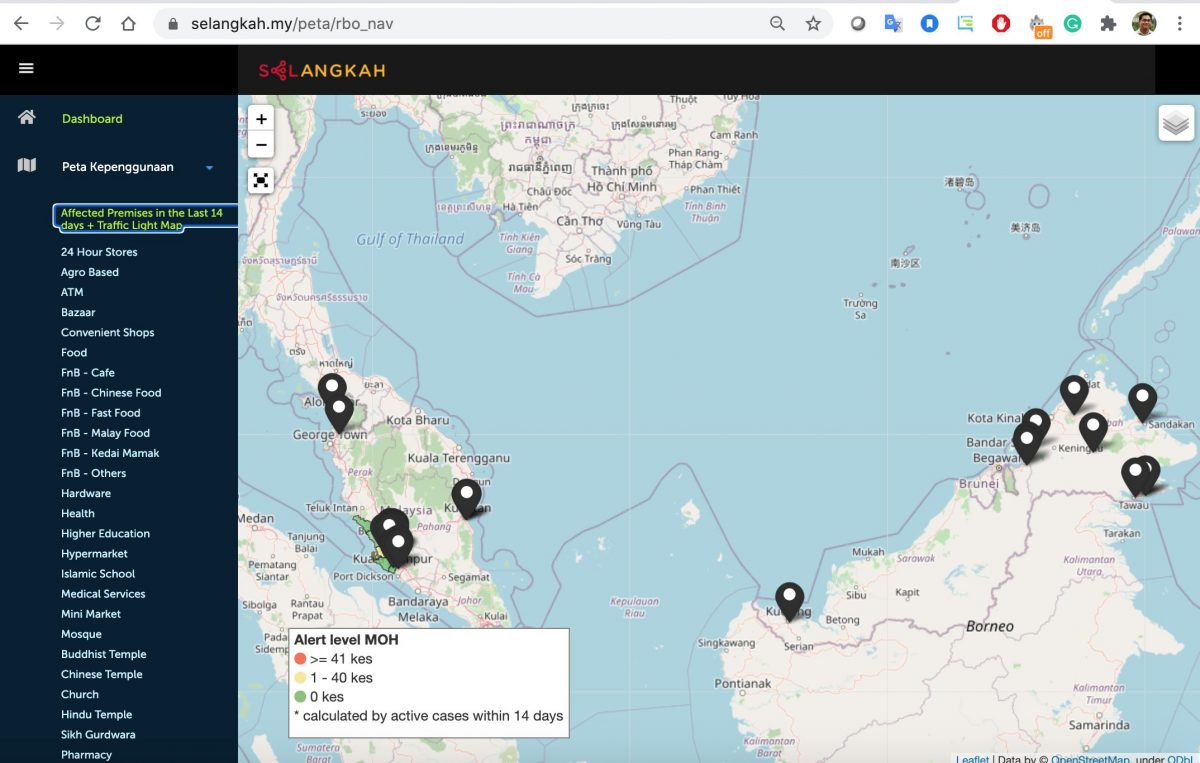KUALA LUMPUR, Sept 29 — The Selangor state government’s SELangkah contact tracing app has released a nationwide map that shows premises patronised by Covid-19 patients in the past 14 days.
SELangkah founder Dr Helmi Zakariah said the information on the SELangkah Map, which is currently available only on desktop, depends on internal notification from the Selangor state health department for Selangor cases and public reports for premises outside the state.
The SELangkah Map, which was launched at the end of August, names the premises that have reported Covid-19 cases and the dates these premises issued statements about the cases. The premises shown on the map do not indicate the number of cases, as a particular Covid-19 patient may have visited more than one location in the past 14 days before undergoing testing.
“We inform the shop owner first, then we monitor. If there’s later a positive case registered there, it will pop up on our map,” Dr Helmi told CodeBlue yesterday.
The feature on the SELangkah Map — which reveals premises visited by coronavirus cases through its “Affected Premises in the Last 14 days + Traffic Light Map” tab — showed 11 premises in Kuala Lumpur and Selangor that have reported positive Covid-19 cases, as of yesterday.
Among them are five shopping centres that have released statements about Covid-19 cases reported in their premises, such as NU Sentral and Sunway Pyramid, as well as two residential apartments in Shah Alam and in Kuala Lumpur. The SELangkah Map, however, also listed KL Gateway Mall, although the shopping centre confirmed on September 27 that a suspected case in its premises, who was in close contact with a Covid-19 patient, had tested negative.
The map also highlighted a shopping centre and a girls’ boarding school in Negri Sembilan visited by a Covid-19 case, as well as three premises (two schools and the Kuantan TBS bus terminal) in Kuantan, Pahang. All of these premises were recently highlighted by Kuantan health authorities in a Covid-19 case’s travel history. The SELangkah Map also lists two locations in Kedah, including the Kedah state government building; a hotel in Kuching, Sarawak; and eight premises in Sabah visited by Covid-19 cases.
The SELangkah Map, however, does not appear to take into account a person’s entire travel history in certain Covid-19 cases, such as that of the Public Works Department (JKR) engineer. The map highlights the JKR headquarters in Kuala Lumpur and a hotel in Kuching, both dated September 17, the day when JKR issued a statement about the Covid-19 case who had visited those locations, among others. SELangkah’s tracker did not include other premises that JKR mentioned its employee had patronised, such as Parliament, the Works Ministry’s office in Kuala Lumpur, and JKR Sarawak in Kuching, even though the female engineer had visited these places after going to her office at the JKR headquarters in Kuala Lumpur from September 7 to 9.
Dr Helmi said the SELangkah Map takes into account an infection source too, but only in Selangor if and when the state health department shares the information with the SELangkah team. The state health department is under the jurisdiction of the federal Ministry of Health (MOH).
“The data sharing has been transient, unlike before MySejahtera came into the picture,” Dr Helmi lamented.

MOH’s MySejahtera Covid-19 management app, which has been pushed by the federal government for contact tracing use in premises, earned public criticism for not listing premises in its hotspot tracker that have publicly issued statements about discovering coronavirus cases.
MOH’s daily official Covid-19 statements do not specify the premises where Covid-19 cases were reported or the locations visited by these patients in the 14 days before their coronavirus tests, often only the state where the cases were reported.
MySejahtera said in a statement yesterday that it only considers a location a Covid-19 hotspot based on “in-depth investigation by MOH on the definite and possible source of infection”, according to “facts and science”.
MOH’s 14-day Covid-19 moving charts — which designate districts based on the number of new local Covid-19 cases officially reported in the past fortnight (green for zero cases, yellow for one to 40 cases, and red for 41 cases and above) — exclude infections imported from abroad, as well as inter-state and inter-district cases.
Kuala Lumpur, for example, is wholly green, according to MOH’s September 15-28 moving chart, except for the yellow district of Titiwangsa with two local cases. This classification comes despite seven Covid-19 cases reported in the capital city by MOH in that period, including six who had returned from Sabah.
The same discrepancy — amid a rise in Covid-19 patients who live in the peninsula but previously travelled to Sabah that is experiencing a surge in coronavirus cases — occurs in Selangor. According to MOH’s 14-day moving chart yesterday, only four districts in Selangor are yellow, with five cases in total: Hulu Langat (two cases), and one case each in Petaling, Klang, and Sepang. However, from September 15 to 28, a total of 30 Covid-19 cases were officially reported in Selangor, including 24 who previously visited Sabah.
Unlike cases imported from abroad — who are subjected to mandatory 14-day quarantine upon arrival in Malaysia — people returning to other parts of the country from Sabah were only tested upon arrival from September 27 and will be released from home quarantine pending their test results that usually take a few days. Before this rule came into force, some people living in the peninsula, who had returned from Sabah, have spread the coronavirus infection locally to their close contacts, such as the Jalan Apas cluster in Selangor reported yesterday with eight positive cases so far, including a couple who had visited Sabah from September 13 to 16.
The authorities appear to use MOH’s moving charts to determine where to impose localised lockdowns. Four districts in the east coast of Sabah that are designated red zones — Tawau, Lahad Datu, Semporna, and Kunak — have been placed under an administrative Targeted Enhanced Movement Control Order (TEMCO) from today until October 12. Kota Setar, which is also a red zone in Kedah, was previously put under TEMCO from September 11 to 25.








